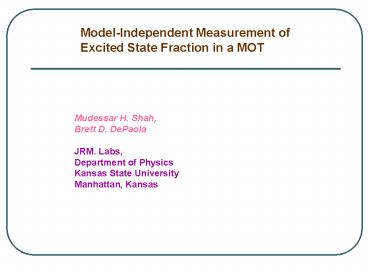Model-Independent Measurement of - PowerPoint PPT Presentation
1 / 48
Title:
Model-Independent Measurement of
Description:
Model-Independent Measurement of. Excited State Fraction in a MOT ... Dumper. Laser Locking. setup. Laser Locking. setup. Generic MOT Setup. Double Pass AOM ... – PowerPoint PPT presentation
Number of Views:27
Avg rating:3.0/5.0
Title: Model-Independent Measurement of
1
Model-Independent Measurement of Excited State
Fraction in a MOT
Mudessar H. Shah, Brett D. DePaola JRM.
Labs, Department of Physics Kansas State
University Manhattan, Kansas
2
Outline
- Motivation
- Introduction To a MOT
- Theoretical Models
- Experimental Setup
- Experimental Results
- Conclusion
3
Motivation
- Absolute photo-ionization cross sections
- Cold atom collisions cross sections
- Photo-association spectroscopy
- Total number of atoms in a MOT
4
How MOT Works!
5
Total Number of Atoms in a MOT.
For known Intensity and Detuning f is
calculated using simple Model
6
Simple ModelTwo level system
Dilute Gas
Laser Beam
- A plane traveling wave
- Linearly polarized
- Intensity is low
Polarization is parallel to dipole moment
Ref W. Demtröder, Laser Spectroscopy. (Springer,
2002)
7
Complex System
2
1
- System is multilevel
- Standing wave
- Circularly polarized
- Intensity is not low
8
Modified Simple Model
C1 and C2 are the average Clebsh-Gordan
coefficients (2- parameter Model)
Ref Phys. Rev. A 52, 1423 (1995)
9
Multi-level Model An Ansatz
Here ?-1/2 and ß-1/2 are the CGCs, and Sr
defines the low and High Intensities regimes for
S ltlt Sr, Is ?Is for S gtgt Sr,
Is ßIs
Phase MMT ? ß Sr
0 1.712 3.321 1.541
Random 1.259 1.620 1.045
Ref J. Opt. Soc. Am. B 10, 572 (1992)
10
System Studied
11
Generic MOT Setup
12
Generic MOT Setup
13
Double Pass AOM
14
Experimental Setup
(MOTRIMS)
Ref Nucl. Instrum. and Meth. Phys. Res. B 205,
191 (2003)
15
What do Q-values tell us?
16
(No Transcript)
17
How to deduce excited fraction?
18
Experimental Parameters
B-Field 12.5, 7.22 G/cm
Trap Intensity Balance 25.3 36.1 30.7 mW/cm2
Trap Intensity Balance 17.2 30.2 40.7 mW/cm2
Re-Pump 3.26, 1.37, 0.85 mW/cm2
Total intensities 36-134 mW/cm2
Detuning Range 4.9??/??1.57
MOT temperature 130 µ Kelvin
19
Intensity vs Detuning (Raw Data)
A density plot of power and detuning Detuning in
16 equal steps Power in terms of ADC channels
20
Results Intensity and Detuning Variation
Re-Pump 3.26 mW/cm2
Total intensities 36-134 mW/cm2
B-Field 12.5 G/cm
Intensity Balance 25.3 36.1 30.7 mW/cm2
21
Intensity Balance
Trap Intensity Balance 17.2 30.2 40.7 mW/cm2
Re-Pump 3.26mW/cm2
22
B-field effects
B-Field 7.22 G/cm
Trap Intensity Balance 25.3 36.1 30.7 mW/cm2
23
Re-pump variation
B-Field 12.5 G/cm
Trap Intensity Balance 25.3 36.1 30.7 mW/cm2
Re-Pump 3.26, 1.37, 0.85 mW
24
Gensemer Absolute Photo-Ionization Data
25
Simple Model (1- Parameter Fit)
1-Parameter fit Is 9.2 mW/cm2
26
1-Parameter Residuals
27
Modified Simple Model (2-Parameter Fit)
2-Parameters C1 0.610 C2 0.645
28
2-Parameter Residuals
29
Multi level model (3-Parameter Fit)
No high and low intensity regimes so it is
essentially the same as 1 or 2 parameter model!
30
Conclusions
Thanks to DOE
31
Conclusions
- First time excited state fraction is measured
by - model independent method.
- Theory and experiment are in good agreement
- within the parameter space of a good
trap. - Results are, at most, weakly dependent on
other - trap parameters.
- Three parameter ansatz does not work very
well - For two parameters C1 0.610, C2 0.645
- For one parameter Is 9.2 mW/cm2
Thanks to DOE
32
Special Thanks to
MOTRIMS Team
JRM Labs People! Thanks for your attention!
33
Special Thanks to
MOTRIMS Team M. L. Trachy, G. Veshapidze, H.
Camp Brett D. DePaola JRM Labs People Thanks
for your attention!
34
Ai area under the peak ni number of atoms
in a peak ?i Charge transfer cross section C
target thickness, acquisition time
35
Relative Cross Section
36
(No Transcript)
37
(No Transcript)
38
(No Transcript)
39
(No Transcript)
40
Double Pass AOM
41
Complex System
MF
0
1
-1
-2
2
- Standing wave
- Circularly polarized
- Intensity is not low
- System is multilevel
1
-1
0
42
System Studied
43
Simple ModelTwo level system
Approximations
- A plane traveling wave
- Linearly polarized
- Intensity is low
- Two level system
- Electric dipole
- Rotating wave
Polarization is parallel to dipole moment
Ref W. Demtröder, Laser Spectroscopy. (Springer,
2002)
44
Complex System
- System is multilevel
- Standing wave
- Circularly polarized
- Intensity is not low
45
Two level system
46
Motivation
- Formulae where it is being used
47
Experimental Setup
(MOTRIMS)
Ref Nucl. Instrum. and Meth. Phys. Res. B 205,
191 (2003)
48
Experimental Setup
(MOTRIMS)
Ref Nucl. Instrum. and Meth. Phys. Res. B 205,
191 (2003)

